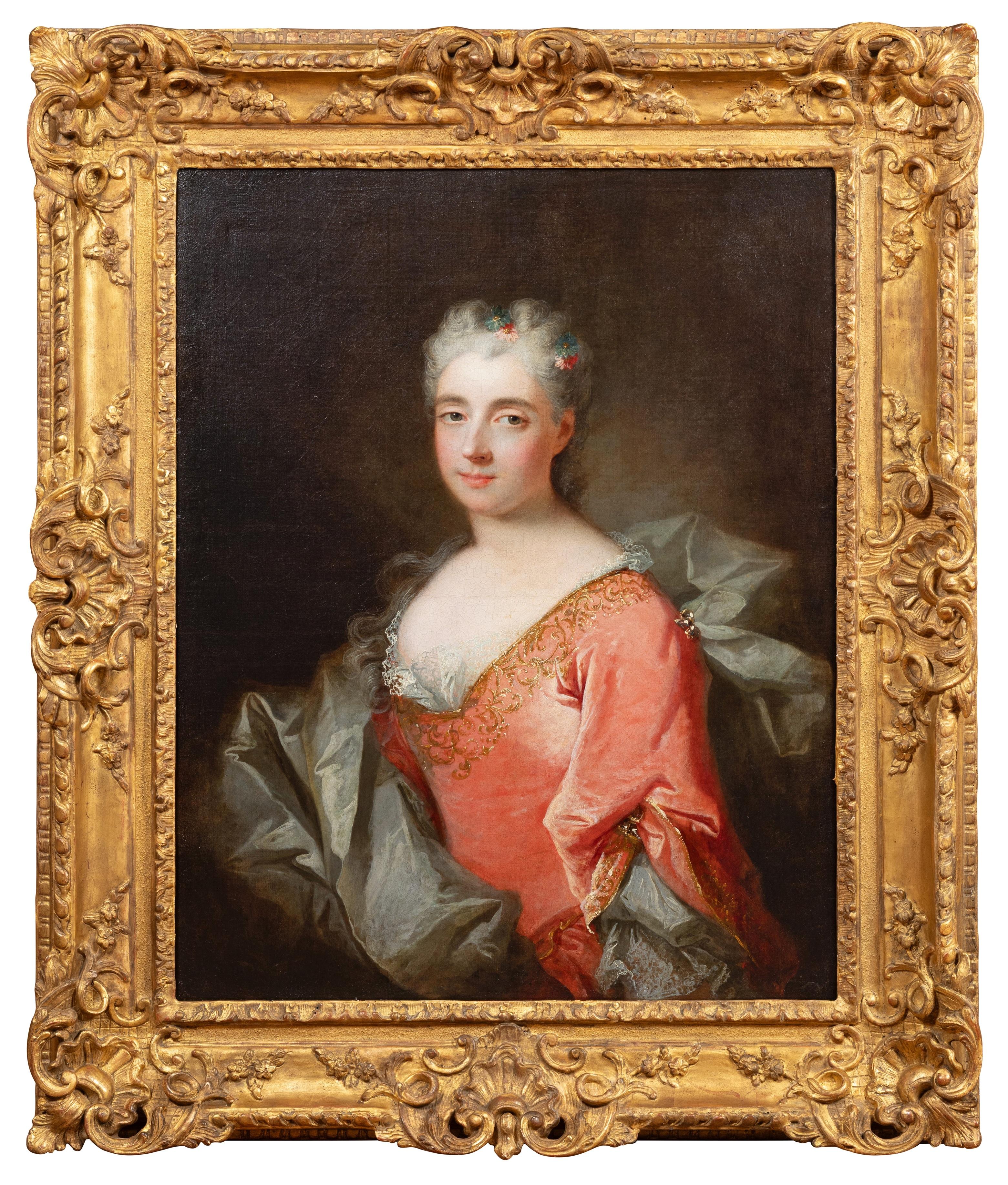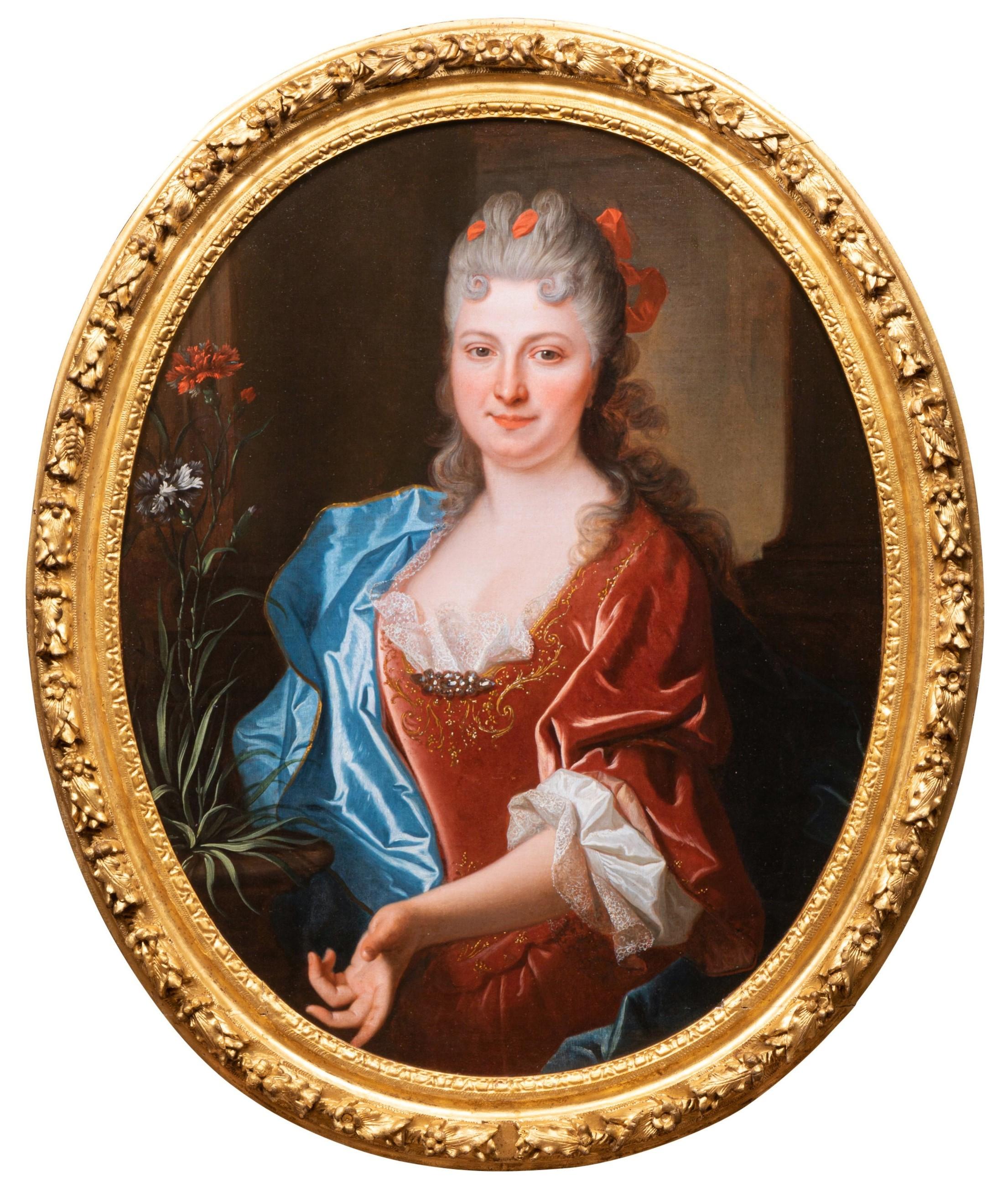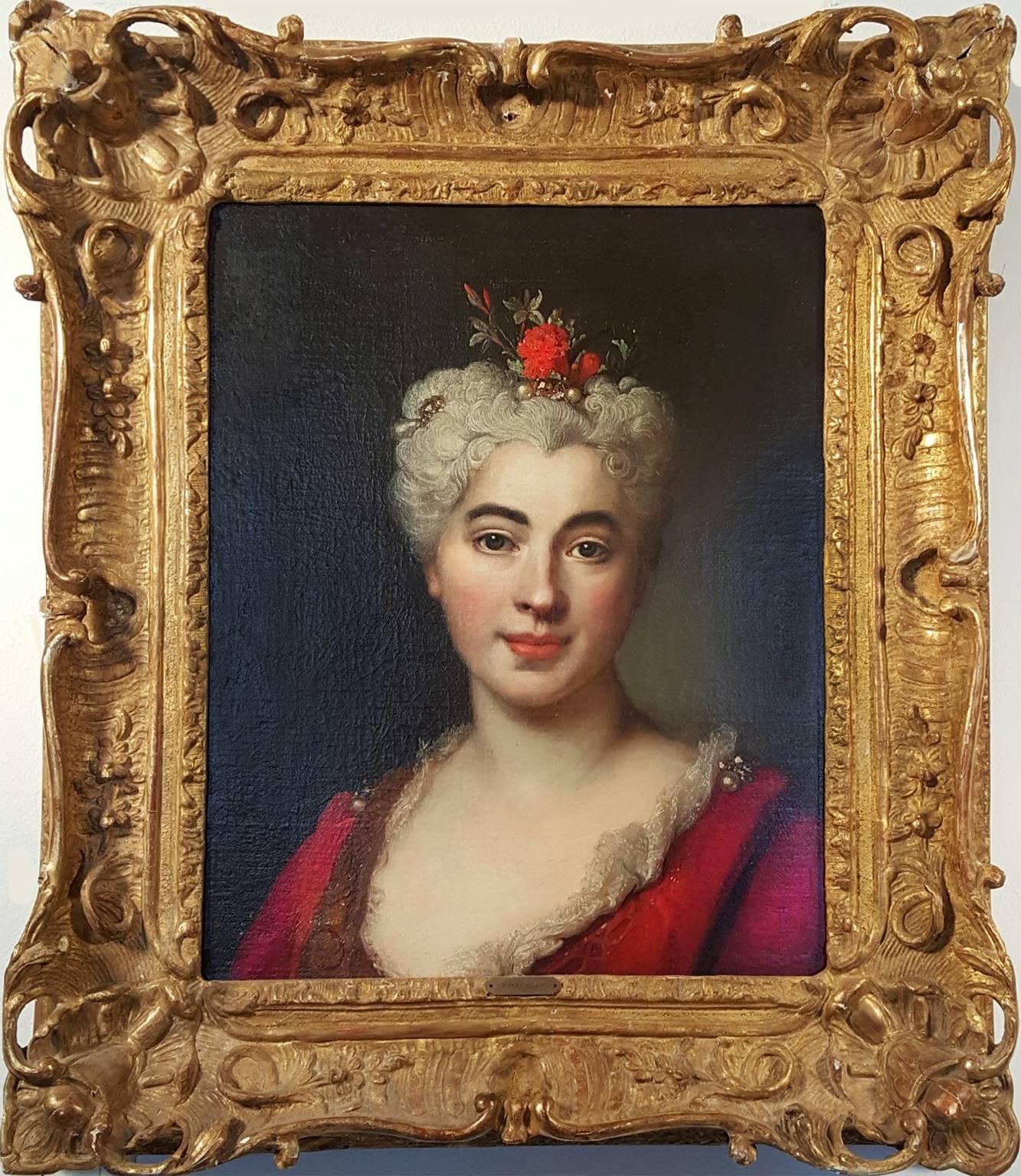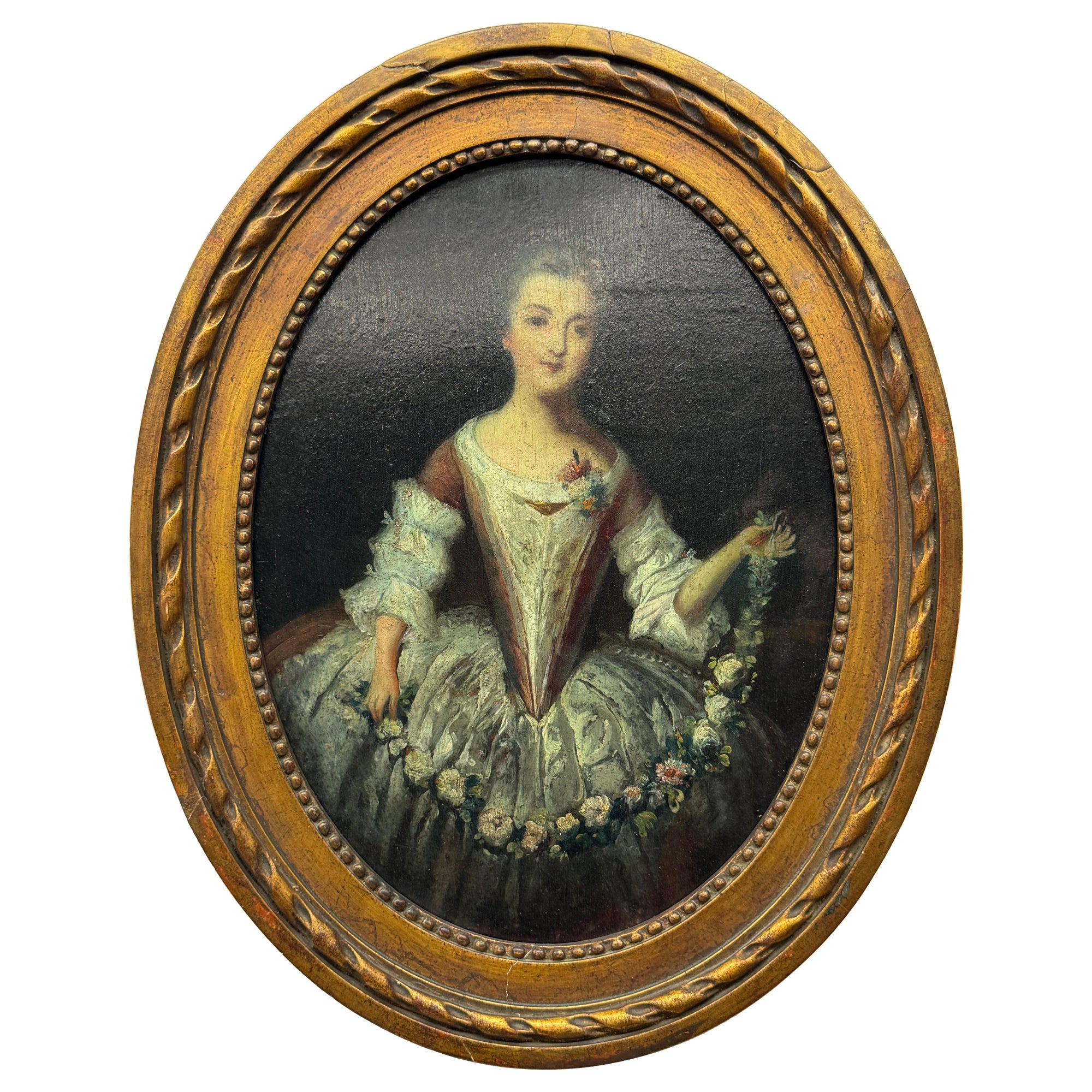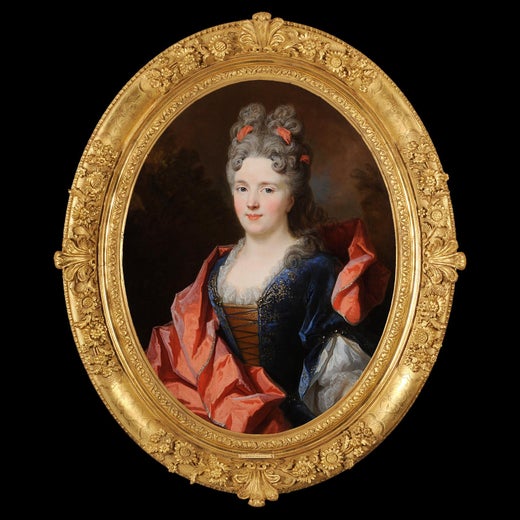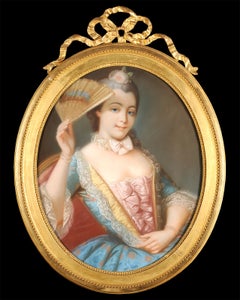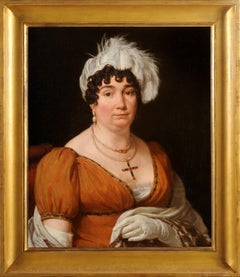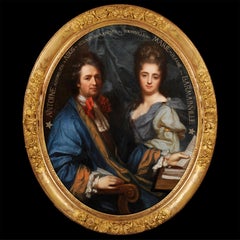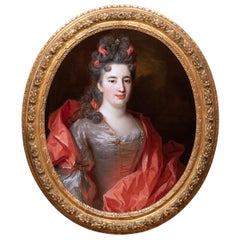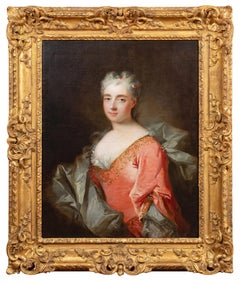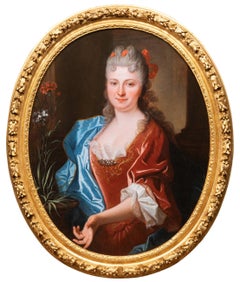Items Similar to Presumed portrait of Marie-Anne de Bourbon
Want more images or videos?
Request additional images or videos from the seller
1 of 12
Nicolas de Largilli�èrePresumed portrait of Marie-Anne de BourbonCirca 1700
Circa 1700
$47,674.80
£35,302.90
€40,000
CA$65,560
A$72,919.56
CHF 38,164.54
MX$889,378.19
NOK 479,551.30
SEK 451,079.90
DKK 304,532.33
About the Item
Nicolas de LARGILLIERRE
(Paris 1656 – 1746)
Portrait of a woman, presumed to be Marie-Anne de Bourbon, Princess of Conti (1666-1739)
Oil on oval canvas
H. 80 cm; L. 61 cm (107 x 91 cm for frame)
Provenance: French family settled in Italy
Son of a Parisian hatter, Nicolas de Largillierre settled at the age of three in Antwerp with his parents. After a stay of twenty months in London, in 1665-1666, he was placed in the studio of the Antwerp painter Antoon Goubau (1616-1698), who specialized in bambochades. Quickly collaborating in the works of his master, who let him paint piles of fruit and vegetables, Largillierre perfected his education in contact with the works of Pierre-Paul Rubens and his entourage. A second stay in London, between 1675 and 1679, allowed him to deepen his knowledge of Flemish still lifes and to appropriate Van Dyck's style. After Sir Peter Leley (1618-1698), first painter to King Charles II, entrusted him with some painting restoration work by the portrait painter, Largillierre assisted the Italian painter Antonio Verrio (1639-1670) for the decorations of the royal apartments of the Windsor Castle. Despite the protective measures taken for Verrio and his team (including a certain "Nicholas de Lauzellier" behind whom Largillierre must be understood), the persecutions aimed at Catholics prompted the French painter to leave England for his settle in Paris. Introduced to the powerful Charles Le Brun (1619-1690), the success of the portraitist was then immediate: approved at the Royal Academy of Painting and Sculpture on March 6, 1683, Largillierre was received there on March 30, 1686 on presentation of the famous Portrait by Charles Le Brun (Paris, Louvre Museum). Private orders then flowed in, bringing in their wake official orders, notably from the aldermen of the City of Paris. At the same time, the portrait painter had a brilliant career as a teacher within the Academy, since he was successively appointed professor in 1705, rector in 1722, chancellor in 1733, then director from 1738 to 1742. following year, at an advanced age, that Largillierre definitely put down his brushes. Nicolas de Largillierre was at the turn of the 18th century, with his rival Hyacinthe Rigaud (1659-1743), the most famous portrait painter in France. The interest that his work arouses today with the public as well as amateurs and art historians responds perfectly to his past vogue. His corpus consists of several hundred portraits, religious subjects, still lifes and rare drawings, mainly from academies. Throughout his career and even today, the artist never ceases to fascinate. From a family tradition, this portrait is considered to be that of the Princess of Conti, Marie Anne de Bourbon, also known as Mademoiselle de Blois. She is a legitimized daughter of Louis XIV and Louise de La Vallière, and her father's favourite… A portrait of Mademoiselle de Blois by François de Troy bears a certain resemblance to our model. However it remains strange that a princess of the blood is portrayed by the great Largillierre in such a simple oval, without hands, without artifices and objects surrounding it.
- Creator:Nicolas de Largillière (1656 - 1746, French)
- Creation Year:Circa 1700
- Dimensions:Height: 31.5 in (80 cm)Width: 24.02 in (61 cm)
- Medium:
- Movement & Style:
- Period:1700-1709
- Condition:
- Gallery Location:BELEYMAS, FR
- Reference Number:1stDibs: LU1857215441142
Nicolas de Largillière
Nicolas de Largilliere (Paris, 1656-1746) Born in Paris, Nicolas de Largilliere spent his childhood in Antwerp. Trained there in the studio of Antoine Goubeau, who taught him the study from nature, Nicolas de Largillierre remained faithful to his precepts throughout his career. In 1673 he went to England where he worked as an assistant in the studio of the portrait painter Peter Lely for almost seven years. He was approved by the Royal Academy upon his return to France in 1683 and was received three years later as "painter of portraits and history"). The portrait is by far the genre that dominates an immense production of nearly 1,500 works produced in a workshop through which many renowned painters will pass. He is with Rigaud the most brilliant portraitist of the end of the XVIIth and the beginning of the XVIIIth century. Rigaud, however, is the official court portraitist, Largillierre works mainly for a wealthy bourgeois clientele. His work brilliantly illustrates the French high society under the reigns of Louis XIV and Louis XV, by an exceptional sense of observation he was able to render, sometimes without complacency, the individuality of the faces and the psychology of the characters.
About the Seller
3.0
Vetted Professional Seller
Every seller passes strict standards for authenticity and reliability
Established in 2017
1stDibs seller since 2022
5 sales on 1stDibs
- ShippingRetrieving quote...Shipping from: BELEYMAS, France
- Return Policy
Authenticity Guarantee
In the unlikely event there’s an issue with an item’s authenticity, contact us within 1 year for a full refund. DetailsMoney-Back Guarantee
If your item is not as described, is damaged in transit, or does not arrive, contact us within 7 days for a full refund. Details24-Hour Cancellation
You have a 24-hour grace period in which to reconsider your purchase, with no questions asked.Vetted Professional Sellers
Our world-class sellers must adhere to strict standards for service and quality, maintaining the integrity of our listings.Price-Match Guarantee
If you find that a seller listed the same item for a lower price elsewhere, we’ll match it.Trusted Global Delivery
Our best-in-class carrier network provides specialized shipping options worldwide, including custom delivery.More From This Seller
View AllPortrait of a young woman in Louis XV period dress
Located in BELEYMAS, FR
French School
Portrait of a young woman in Louis XV period dress
Pastel on paper mounted on oval canvas
H. 68 cm; W. 54 cm (Frame: H. 102 cm; W. 71 cm)
18th century frame, anti-refle...
Category
Mid-18th Century French School Figurative Paintings
Materials
Canvas, Paper, Pastel
Portrait of Madame Leblond
Located in BELEYMAS, FR
French school circa 1815
Portrait of Madame Leblond
Oil on canvas
H. 66 cm; W. 55 cm
Named on the back
Comparable to the works of painters such as Louis Hersent, our portrait, unsig...
Category
1810s French School Figurative Paintings
Materials
Canvas, Oil
Portrait of a woman in front of a landscape in a trompe l'œil
Located in BELEYMAS, FR
French school circa 1810
Portrait of a woman in front of a landscape in a trompe l'oeil
H. 106 cm; L. 91 cm
Oil on canvas
Preserved in its original vine leaf frame, this large portr...
Category
1840s French School Portrait Paintings
Materials
Canvas, Oil
Portrait of a couple
Located in BELEYMAS, FR
Jean-Baptiste SANTERRE
(Magny en Véxins 1651 - Paris 1717)
Portrait of a couple
Oil on original oval canvas
H. 115 cm; L. 90 cm (140 x 115 cm with frame)
Around 1695
Jean-Baptiste S...
Category
1690s French School Portrait Paintings
Materials
Canvas, Oil
Presumed artist self-portrait
Located in BELEYMAS, FR
Louis-Gabriel BLANCHET
(Versailles, 1701 – Rome, 1772)
Presumed self-portrait of the artist
Oil on canvas
H. 73 cm; W. 60 cm
Circa 1730
Originally presented in a Restoration period frame with a "Mignard" cartouche, this beautiful painting initially appeared to us as a work from northern Italy. However, it exuded a rather French form of refinement, suggesting that its artist may have assimilated a dual influence from both sides of the Alps.
We thank our colleague and friend Philippe Mendès for spontaneously and judiciously "bringing out" the name of Louis-Gabriel Blanchet, a Romanized French portraitist, whose spirit and stylistic characteristics we clearly recognize here.
Blanchet's "French" years, before his final departure for Rome in 1728, following his winning of the second Grand Prix for painting after Subleyras in 1727, are extremely poorly documented. His father, Gabriel, was valet to Blouin, himself Louis XIV's first valet at the time. According to Thierry Lefrançois, Blanchet was one of the few students of Nicolas Bertin (1667-1736), whose studio he is said to have joined in the early 1720s. At a baptism on March 24, 1724, where he was godfather, he is mentioned as a painter in the picture store of the Duke of Antin, the director of buildings between 1708 and 1736. At this time, he was probably already married to Jeanne Quément, with whom he had a daughter also named Jeanne, who would marry Nicolas Aviet, the son of a valet in the queen's wardrobe, in Versailles in 1738.
When Blanchet arrived in Rome in October 1728, he was accompanied by Subleyras, Trémolières, and Slodtz. He enjoyed the goodwill of Vleughels, the director of the Académie de France, which had been based at the Palazzo Mancini since 1725, even though the latter was not always kind to our resident. From 1732, he was under the protection of the Duke of Saint-Aignan when he took up his post as ambassador to Rome. Along with Slodtz and Subleyras, they formed a trio of friends, joined by Joseph Vernet shortly after his arrival in Rome in 1734. Slodtz and Blanchet, on the occasion of Subleyras's marriage in 1739, were there to attest that their friend was not bound by any marital commitment, and Blanchet was a witness at Vernet's wedding in 1745.
It is most likely from these early years in Rome that our portrait of the artist dates, the expression and turn of his face irresistibly reminiscent of a self-portrait. The still relatively youthful features may correspond to Blanchet's thirty-something years, and the fluffy wig was still fashionable at this time.
The painting fits well with the depiction of a young painter wanting to display both the beginnings of success and a certain simplicity or restraint. A slight smile expresses a form of assurance in this man with a gentle, sincere gaze and a face radiating a keen sense of wit. We find here the air of intimacy present in almost all of Blanchet's portraits, even those from the 1750s and 1760s, as well as an almost complicity with the viewer. The spirit of the painting is quite close to that of the presumed portrait of Bouchardon (painted around 1730) and the portrait of Pannini, painted in 1736, but it possesses a more natural quality, notably thanks to the absence of decorum. Our work exhibits the characteristics of Blanchet's paintings: elegance, luminosity (especially in the whites), vibrant and refined colors (here, the harmony of the garnet of the garment and the slate blue of the background, whose uniformity is tempered by a very sketched landscape and a grove of greenery), light complexions, rather rosy cheekbones, often full lips, and rather tight framing.
According to the Academy's rules, Blanchet's stay should have ended in the spring of 1732, but, for reasons unknown, he remained in the Eternal City until his death, as did his friend Subleyras, with whom he shared accommodation until the late 1730s. The latter regularly called upon him to collaborate on his paintings, such as The Meal at Simon's. Through Saint-Aignan's intervention, Blanchet was employed in the late 1730s by the Stuart princely family, then exiled in Italy. He notably produced copies (now lost) after Liotard of the portraits of Charles Edward and Henry Benedict, the sons of James III Stuart. The latter also commissioned three other portraits (now in the National Portrait Gallery in London), whose more formal character contrasts with the intimate spirit of Blanchet's portraits. Blanchet frequented English painters, such as the landscape painter Richard Wilson, and studied with the Scottish portraitist Katherine Read...
Category
1730s French School Portrait Paintings
Materials
Oil, Canvas
Portrait of a woman with a book
Located in BELEYMAS, FR
Italian school circa 1560, circle of Bernardino Campi
Portrait of a woman with a book
Oil on panel
H. 78 cm ; L. 57cm
Category
16th Century Italian School Portrait Paintings
Materials
Oil, Wood Panel
You May Also Like
Nicolas de Largillière - Portrait of a Lady, Paris, circa 1695
By Nicolas de Largillière
Located in PARIS, FR
Nicolas de Largillière (Paris, 1656-1746)
Portrait of a lady, circa 1695
Oil on canvas (relined): 76 x 61 cm
Framed: h. 97 cm, l. 82 cm
To be included in the forthcoming catalogue raisonné of the artist by Dominique Brême, director of museum of Sceaux and artist specialist.
Our work presents a majestic French aristocrat against the backdrop of a twilight landscape.
The face seen from the front, the body turned three-quarters, the young woman is portrayed half-length, revealing her slim belted waist.
The elongated face with rosy cheeks, almond-shaped eyes, straight nose and strong chin, solemn expression, the young woman sketches...
Category
1690s Old Masters Figurative Paintings
Materials
Canvas, Oil
Portrait of a French lady by Robert Le Vrac Tournieres, circa 1725
Located in PARIS, FR
Portrait of a young Lady
Robert Le Vrac Tournières (1667-1752)
18th century French school, circa 1725
Oil on canvas
Dimensions: h. 81 cm, w. 65 cm
Important 18th century Régence per...
Category
Early 18th Century Old Masters Portrait Paintings
Materials
Canvas, Oil
18th c. French Portrait of a Lady by Jean Ranc (1674 - 1735), Paris circa 1700
Located in PARIS, FR
Portrait of a Lady with carnations
By Jean Ranc (Montpellier 1674 - Madrid 1735), circa 1700
Oil on canvas in oval shape,
Dimensions: h. 35.82, w. 28.34 in.
Period Louis XIV giltwood and carved frame with laurel leaves.
Framed dimensions: h. 42.52 in, w. 33.85 in.
Provenance: Collection of the Marquis de Bailleul at the Château d'Angerville-Bailleul (before 1942).
To be included in the catalog raisonné of the artist by Stephane Perreau
Important portrait of a young woman depicted half-length turned three-quarters, her face looking at the viewer.
Dressed in a brick red velvet dress, an elegant blue scarf envelops her figure.
Hair styled “a la Fontange”, her powdered hair is raised and tied at the back with a red ribbon, several curly locks escape from her bun and fall on her back and shoulders.
The perfectly oval face with regular features dominated by her straight nose is softened by her gray eyes with slightly lowered lids. The red tinged skin tones on the cheeks and cheekbones color the face and make the portrait come alive.
The young woman is portrayed standing near a pot of carnations. Her strongly lighted figure stands out against an architectural background of columns.
The artist's palette is made of contrasts opposing warm to cold hues. The icy electric blue contrasts with the fiery brick red, the hair powdered with white accentuates even more the flush of the cheeks.
The left arm bent at the elbow, extending the open hand with slightly bent fingers in the foreground brings depth to the composition.
Our portrait, an interesting testimony in the corpus of works of the painter, is part of his youthful period, around 1700-1705.
The former belonging of this portrait to the Marquis de Bailleul reinforces the remarkable character of our painting.
The portrait has been examined by Stéphane Perreau, specialist of Jean Ranc and will be included in the catalog raisonné currently being written, under number P. 43. The notice edited by Mr Perreau is below:
"Painted around 1700-1705, this portrait of a woman is directly inherited from Hyacinthe Rigaud, the master of Jean Ranc (the hand turned over the front, in a watch...
Category
Early 18th Century Old Masters Portrait Paintings
Materials
Canvas, Oil
Attributed to MILLOT, Henri Portrait of a Lady
Located in Berlin, DE
Attributed to MILLOT, Henri. Portrait of a Lady. Oil on canvas. Unsigned, inscribed Millot on the reverse. 18th century. 85 x 69 cm. Framed. 85 x 69 cm. Portrait of a young woman in ...
Category
1720s Baroque Figurative Paintings
Materials
Oil
Portrait Of Elisabeth Marguerite, The Artist's Daughter
By Nicolas de Largillière
Located in Miami, FL
Nicolas de Largillierre painted Elisabeth Marguerite in oil on canvas. A larger version of this work was offered by Sotheby's for $500,000 and is now in a French Museum - Palais ...
Category
18th Century and Earlier Rococo Portrait Paintings
Materials
Canvas, Oil
Samuel Seeberger - Portrait of Louise-Marie of France
By Samuel Seeberger
Located in San Francisco, CA
Samuel Seeberger(French) Portrait of Louise-Marie of France
After Jean-Marc Nattier
Oil on wood panel
11.5" x 15.5" unframed, 15.5" x 19.5" framed
Category
Early 20th Century French School Portrait Paintings
Materials
Oil, Wood Panel
More Ways To Browse
Antique Bourbon
De Nicola
Nicola L
Flemish Portrait Painting
Antique Catholic Art
Oval Italian Painting
Anne Marie Of France
Antique Catholic Painting
Windsor Oil Paintings
Oil Painting King Louis
Flemish Sculpture
Le Brun
18th Century Settle
King Charles Ii
Painting Of Bourbon
18th Century Italian Religious Paintings
Antique Paintings Peter Paul Rubens
Princess Anne

